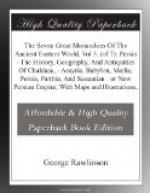The ordinary defence of the Persian against the weapons of his enemy was a shield of wicker-work, which covered him almost from head to foot, and which probably differed little from the wattled shield of the Assyrians. [PLATE XXX., Fig. 2.] This he commonly planted on the ground, supporting it, perhaps, with a crutch, while he shot his arrows from behind it. Occasionally, he added to this defence the protection of a coat of mail, composed either of scale armor, or of quilted linen, like the corselets of the Egyptians. Armor of the former kind was almost impenetrable, since the scales were of metal—iron, bronze, or sometimes gold—and overlapped one another like those of a fish.
The Persian cavalry was armed, in the early times of the monarchy, almost exactly in the same manner as their infantry. Afterwards, however a considerable change seems to have been made. In the time of the younger Cyrus cavalry soldiers were very fully protected. They wore helmets on their heads, coats of mail about their bodies, and greaves on their legs. Their chief offensive arms seem, then, to have been the short sword, the javelin, and the knife. It is probable that they were without shields, being sufficiently defended by their armor, which (as we have seen) was almost complete.
The javelin of the horseman, which was his special weapon, was a short strong spear or pike, with a shaft of cornel-wood, and an iron point. It was common for him to carry two such weapons, one of which he used as a missile, while he retained the other in order to employ it in hand-to-hand combat with the enemy. It was a stout manageable weapon, and though no match for the longer and equally strong spear of the Macedonian cavalry, was preferred by Xenophon to the long weak reed-lance commonly carried by horse-soldiers in his day.
It was the practice of the later Persians to protect with armor, not only the horseman, but the horse. They selected for the service large and powerful animals, chiefly of the Nisaean breed, and cased them almost wholly in mail. The head was guarded by a frontlet, and the neck and chest by a breast-piece; the sides and flanks had their own special covering and cuisses defended the thighs. These defences were not merely, like those of the later Assyrian heavy cavalry, of felt or leather, but consisted, like the cuirasses worn by the riders, of some such material covered with metal scales. The weight which the horse had to sustain was thus very great, and the movements of the cavalry force were, in consequence, slow and hesitating. Flight was difficult; and, in a retreat, the weaker animals were apt to sink under their burdens, and to be trampled to death by the stronger ones.




